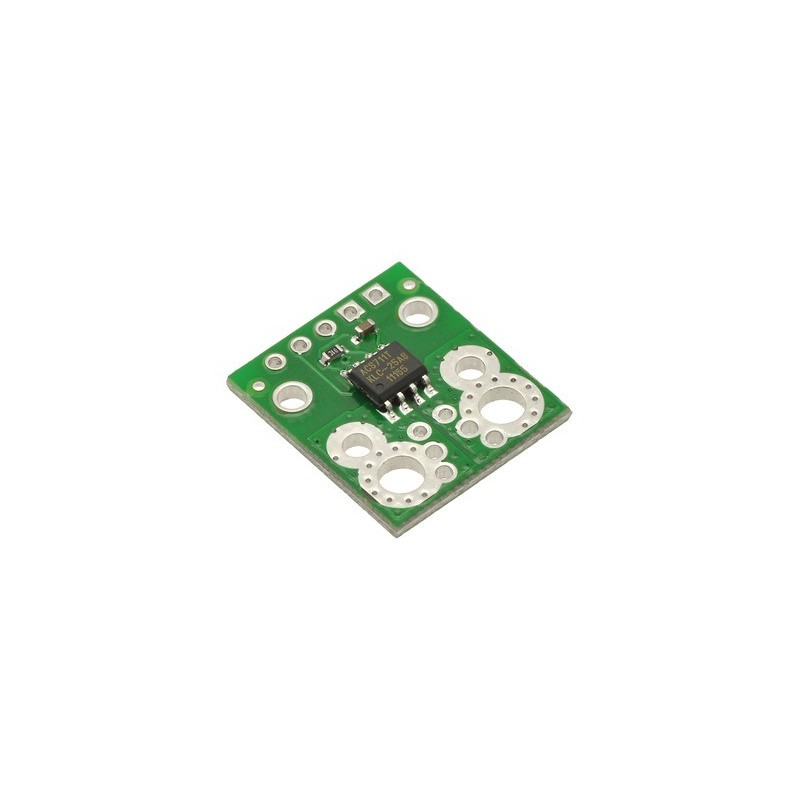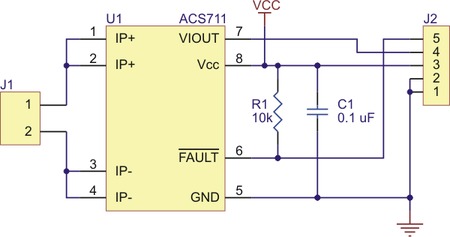- Out-of-Stock

This board is a simple carrier of Allegro’s ±12.5A ACS711 Hall effect-based linear current sensor with overcurrent fault output, which offers a low-resistance (~1.2 m?) current path and electrical isolation up to 100 V. This version accepts a bidirectional current input with a magnitude up to 12.5 A and outputs a proportional analog voltage centered at Vcc/2 with a typical error of ±5%. It operates from 3 to 5.5 V, so it can interface directly to both 3.3 V and 5 V systems.
 |
 |
This current sensor is a carrier board or breakout board for Allegro’s ACS711KLCTR-12AB-T Hall effect-based linear current sensor with overcurrent fault output; we therefore recommend careful reading of the ACS711 datasheet (489k pdf) before using this product. The sensor has an operating voltage of 3 – 5.5 V and an output sensitivity of 110 mV/A when Vcc is 3.3 V (or 167 mV/A when Vcc is 5 V). The following list details some of the sensor’s key features:
The pads are labeled on the bottom silkscreen, as shown in the picture to the right. The silkscreen also shows the direction that is interpreted as positive current flow via the +i arrow.
This 12.5 A current sensor is marked with a purple X. We also sell a 25 A version that uses the same carrier PCB; you can distinguish the versions by reading the text on the IC or by looking at the color of the X on the bottom silkscreen.
The sensor requires a supply voltage of 3 – 5.5 V to be connected across the Vcc and GND pads, which are labeled on the bottom silkscreen. The sensor outputs an analog voltage that is linearly proportional to the input current. The quiescent output voltage is Vcc/2 and changes by 110 mV per amp of input current (when Vcc = 3.3 V), with positive current increasing the output voltage and negative current decreasing the output voltage. For an arbitrary input current i (in amps), the sensor’s output voltage can be more generally represented as:
VOUT = (0.11 V/A * i + 1.65 V) * Vcc / 3.3 V
The FAULT pin is normally high and latches low when the current exceeds ±12.5 A. Once the FAULT pin is latched low, the only way to reset it is by toggling power on the Vcc pin.
|
|
The input current can be connected to the board in a variety of ways. Holes with 0.1?, 3.5 mm, and 5 mm spacing are available as shown in the diagram above for connecting male header pins or terminal blocks. For high-current applications, you can solder wires directly to the through-holes that best match your wires, or you can use solderless ring terminal connectors, as shown in the picture above. The large through-holes are big enough for #6 screws.
The board has two mounting holes on the logic side of the board. These mounting holes are 0.5" apart and are designed for #2 screws.
This board ships assembled with all surface mount components, and a 5?1 strip of 0.1? header pins is included but not soldered in, as shown in the picture below.
 |
| ACS711 current sensor carrier with included 5 ? 1 0.1? header pins. |
|---|
 |
| ACS711 current sensor carrier schematic diagram. |
|---|
 |
ACS714 Current Sensor Carrier -5 to +5A |
 |
ACS709 Current Sensor Carrier -75 to +75A |
 |
ACS711 Current Sensor Carrier -25 to +25A |
Manufacturer BTC Korporacja sp. z o. o. Lwowska 5 05-120 Legionowo Poland sprzedaz@kamami.pl 22 767 36 20
Responsible person BTC Korporacja sp. z o. o. Lwowska 5 05-120 Legionowo Poland sprzedaz@kamami.pl 22 767 36 20
Tamiya 72101 Gear Head Motor + Sponge Tire Set
No product available!
No product available!
Permanent cylindrical neodymium magnet with a diameter of 12 mm and a height of 6 mm.
No product available!
No product available!
HK Turnigy nano-tech 370mah 3S 25~40C Lipo Pack (11895)
No product available!
No product available!
No product available!
Base board dedicated to Raspberry Pi CM4 modules. It is equipped with connectors compatible with Arduino. Waveshare CM4-Duino
No product available!
No product available!
No product available!
No product available!
Thermistor for THT assembly with a resistance of 10k, a temperature coefficient of 3380K and accuracy of 1%. The sensor body is Ø2.5x4mm
No product available!
No product available!
No product available!
The robust hardware design platform which uses the Altera Cyclone V FPGA device as the center control for its peripherals such as the on-board USB Blaster, video capabilities etc. Contains all components needed to use the board in conjunction with a computer that runs the Microsoft Windows XP or later
No product available!
No product available!

